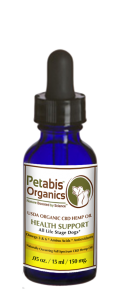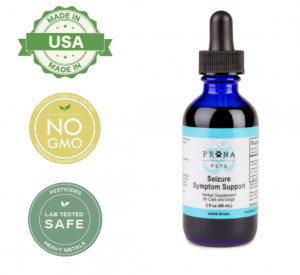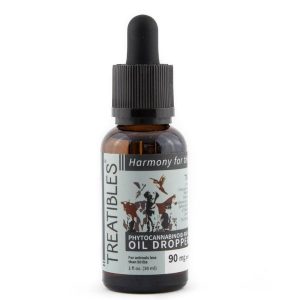Earlier this year, researchers at Cornell University concluded a double-blind study on the effects of CBD oil on dogs suffering from osteoarthritis, an ailment not at all uncommon in our senior pets and people. Over the course of six weeks, dogs were given either CBD oil or an oral placebo, two times daily. Dogs who took the CBD oil showed clear improvement with veterinarians noting a decrease in pain and an increase in activity with no reported side effects.
A different review performed at Colorado State University’s James L. Voss Veterinary Teaching Hospital recently studied how CBD oil affects dogs with epilepsy. The trial consisted of 16 dogs who experienced two or more seizures in the month prior to the research. Seven dogs served as the control group receiving a placebo for 12 weeks before switching to CBD oil for an additional 12 weeks. According to the results, CBD oil was effective in reducing the frequency of seizures in nearly 90% of dogs in the study. These preliminary findings represent the first official steps towards helping dogs with epilepsy find safe and natural relief. Although pharmaceutical options exist, their side effects become unmanageable or the meds fail to be effective in many dogs, so some veterinarians are optimistic that CBD oil might be the answer.
According to Dr. Celeste Yarnall, “In cats, CBD can control pain, inflammation, arthritis, inflammatory bowel disease (IBD), pancreatitis, feline idiopathic cystitis (FIC), feline lower urinary tract disease (FLUTD). It’s neuroprotective, decreases nausea, and stimulates appetite. As we know, it’s very important to keep cats eating and hydrated. CBD can help reduce cancer symptoms, and it’s wonderful for the brain. We’re seeing geriatric dogs and cats with dementia improve. We’re seeing a reduction in bronchospasms in asthmatics, and lowered anxiety. CBD supports the immune system and helps with food allergies and immune-mediated diseases.”
Dr. Gary Richter states, “While there are some differences in how cannabis affects pets compared to humans, they can benefit in many of the same ways people do,” Richter said. He adds that his professional experience “has shown me that there is enormous potential to treat medical conditions with cannabis.”
Dr. Karen Becker, an Integrative Wellness Veterinarian, writes: “When it comes to pain management, there’s a significant amount of evidence that supports the use of CBD. And since cannabinoids work differently in the body than narcotics and also non-steroidal anti-inflammatory drugs, they can be used together without the risk of drug interactions.”
So, what is CBD?
CBD is an acronym for Cannabidiol (Can-a-bid-i-ol), a naturally occurring class of molecules called cannabinoids abundant in the plant genus Cannabis Sativa L. CBD makes up close to 40% of the plant and is just one of over 80 cannabinoids presently identified in cannabis sativa. Penguin CBD interacts with an animal’s naturally occurring endocannabinoid system (more about this under “How does it work?”), and is non-psychoactive because there is little to no THC (tetrahydrocannabinol). In brief, CBD rich sativa plants having low levels of THC are referred to as Hemp and Marijuana plants are those with high levels of THC.
A bit more about Hemp vs. Marijuana
Hemp and marijuana are related in much the same way as dogs are related to wolves. The two plants are varieties of the species Cannabis sativa, and dogs and wolves are sub-species of Canis lupus. Our domestic best friends share some traits with their wilder cousins but there are also many differences. The same can be said when it comes the usage and chemical content of hemp and marijuana, the differences can be night and day.
- First off, the plants look different. One of the oldest domestic crops grown, tall, sturdy hemp plants were farmed by early civilizations for food, oil, shelter and textiles. Similar to bamboo, shoots can grow 15 feet high. Marijuana plants however, tend to grow as low and bushy.
- As far as cultivation, hemp is grown for its stalks and seeds and marijuana for its leaves and flowers.
- The elevated levels of THC in marijuana are responsible for its signature “high,” while hemp has very little THC. A study done by a private laboratory in Denver (Charas Scientific) found that recreational marijuana contains up to 30% THC while the hemp used to create products for pets and people contains a maximum legal amount of .03%. Some companies even go through a costly process to remove all traces of THC in hemp products to improve safety.
- Both hemp and marijuana contain CBD, but the hemp plant produces more, making it the preferred choice to battle anxiety, chronic pain, epilepsy and other ailments. Since CBD does not cause a “high,” it is considered a holistic treatment, not a pharmaceutical one. No risk of overdose with CBD and potential side effects are minimal! In the Veterinary News, Michael Petty, DVM stated, “CBD works towards homeostasis…making unwanted side effects rare and giving CBD a good safety profile.”
- CBD oil from hemp is legal in all 50 states; marijuana is not. There is no need for a prescription or medical card to purchase hemp as oil and other products derived from it are considered to be food-based. Therefore, there are no restrictions on the production, sale or consumption of hemp in the United States as long as it contains ˂ .03% concentrations of the molecule THC.
So keep in mind that CBD and Marijuana are definitely not the same and only one – CBD – is safe for pets. Never ever share edibles, THC or any human-specific cannabis products with your dog or cat! “The number-one animal ER issue in states in which medical and/or recreational marijuana is legal is marijuana intoxication,” says Dr. Robin Downing, DVM and a pain medicine veterinary specialist. “Dogs are very sensitive to THC, and toxic levels can be a real danger for them. A dog may develop an adverse reaction called static ataxia—they stand stiffly with widespread paws, and can’t move other than to rock back and forth. At higher doses they may fall and eliminate on themselves. Some dogs have died from eating marijuana-laced chocolate treats.”
Are all CBD oils created equal?
No. Most CBD oils on the market are NOT naturally occurring NOR are they truly full spectrum CBD. Most undergo a form of chemical synthesis that requires lab manipulation – compounds are taken out during the extraction process and synthesized ones added in. In order to be considered a truly full spectrum CBD oil (which is what you want for Fido or Fluffy), it should contain naturally occuring (Phyto-Cannabinoid Rich) therapeutic parts of the plant. Just like I’m always telling you to read labels on pet foods, I’m saying that again and then some…you need to know how the plants were grown and how the compounds were extracted in order to get the best quality CBD oil for your senior or even younger best pal!
There are several extraction processes, just make sure the oil you give you pet was produced via a clean method. Ethanol, aka grain alcohol, is considered to be a safe method of removing unneeded toxins and residues from hemp. Extractions however, using propane, hexane, pentane and butane are all very dangerous – but manufacturers sadly use them to save money.
The most common extraction is CO2, but in many cases, not only does this method require the cannabinoids, terpenes (the pungent flavors and smells that induce different effects), flavonoids (phytonutrients offering many health benefits and providing the pigment to the plant) and antioxidants (compounds that inhibit oxidation) to be rebuilt, some methods actually add in harmful ingredients as a by-product of the process! During C02 extraction, plant materials are exposed to high heat levels to separate the elements. In order to activate the oil using C02 extraction, the CBD oil must be heated a second time, meaning plants are twice exposed to high levels of heat for up to 2 additional hours in order to activate the oil. During that time, the delicate, beneficial terpenes and flavonoids, as well as most cannabinoids, are burned out of the plant materials.

Explains Heidi Nevala, Founder and President of Petabis, “We utilize a patented water vapor extraction method that processes in seconds instead of minutes or hours and instantly activates oil when extracted, preserving beneficial terpenes, flavonoids and cannabinoid strains intact and in their natural state. It allows us to deliver over 100 known cannabinoids, 30 flavonoids and a 2.49% terpene count — the highest in the world, ensuring you are buying the purest, consistent, most concentrated and nutrient dense, natural phytochemical rich CBD oil for your pets. Our whole flower truly full spectrum CBD Oil extract produces a CLEAR OIL with a nutty, buttery taste because the bitter chlorophylls and bitter carbonic acid flavors are removed, leaving a clear, sweet smelling oil that has not been lab manipulated!”
The hemp plant is considered a hyper-accumulator which means it readily absorbs anything in the soil. According to Prana Pets, “Clean, rich, pesticide and heavy metal free soil equates to a super healthy hemp plant. Soil that is contaminated with lead, mercury or pesticides will transfer its toxicity into the CBD Oil, making it unsafe for pets.”

How does it work?
Dogs, cat, humans, all invertebrates (except insects) have an endocannabinoid system that helps maintain the physiological, neurological and immunological systems of the body — it modulates our emotions, response to pain and other sensations. If there is a deficiency anywhere, multiple receptors can use CBD oil to help the body get into balance or achieve homeostasis. According to Veterinarian Robert J. Silver, “The Endocannabinoid Systems was only discovered in the mid-1990s. It’s so new, it’s not even in the textbooks,” so we still have much to learn yet findings are already showing the symbiotic relationship between this system in our bodies and CBD.
One thing we have learned is that there is a greater concentration of cannabinoid receptors in the brain of a dog than there are in other animals or humans. This higher concentration can make the canine brain react badly to THC, so pet-specific CBD oil is best. Remember, THC ˂.03%.
Obviously, there is still much to learn but many of the conditions researchers are finding that CBD oil aids are rooted in emotional stress, particularly in cats. Said Dr. Yarnall, “Anxiety and stress within the home can render cats unable to moderate their own inflammatory response, triggering a cascade. There’s a bio-physiologic change, then there’s a cellular change and then there’s a structural change. But those structural changes come so far down the line they can often be avoided by addressing inflammation and anxiety early.”
A wondeRUFFul benefit of how CBD interacts with the endocannabinoid system is known as the entourage effect. This is when the many components within the cannabis plant interact with the body to produce a stronger influence than any one of those components alone. When we combine multiple compounds, we don’t end up with the sum of each part but exponentially increase their effects.

Jodi Ziskin, Communications Manager at Treatibles, I feel sums it up best, “All of the compounds from the hemp plant (oils, terpenes, flavonoids, antioxidants) are working together offering pets the greatest benefits. Think of it this way – each compound is like a musical instrument. Wonderful on its own, however as part of a symphony it both supports and is supported by other instruments.”
Anxiety – CBD aids with anxiety by targeting the endocannabinoid system to help the body balance emotions.
Brain Health – CBD from hemp has been shown to support normal cellular function and promote healthy aging via mitochondrial support. In one study on Alzheimer’s in our species, CBD was found to hinder the development of symptoms.
Pain – CBD reduces inflammation in all parts of the body. The same endocannabinoid receptors that work as a team to relieve anxiety also target areas in the body experiencing pain caused by inflammation, nerve damage and other injury. Not a cure for arthritis, CBD though can soothe the inflammation caused by worn down cartilage and helps pets and people feel better and stay active. It can also alleviate intestinal inflammation and is prescribed after surgery and during injury recovery to jump start the immune system for faster healing.
Stimulates Appetite and Fights Nausea
CBD oil triggers the feeling of being hungry allowing an ill pet to ingest necessary nutrients he otherwise might not consume. Ill animals require food to give their body the necessary strength to fight back, but many health conditions shut down appetite. When a pet doesn’t eat, he becomes weak and is even more vulnerable to the type of damage the illness is causing.
Additionally, CBD may help benefit wellness of your dog or cat in these ways:
- Skin & Coat Health
- Digestive Aid
- Immune Support
- Cardiovascular Health
- Palliative Cancer Support
Are there any contraindications with CBD?
CBD Oil has been found safe to be used alongside medications but of course…always use CBD under the guidance of a veterinary professional you trust.
How much CBD oil should I give my dog or cat?
CBD interacts with your pet’s endocannabinoid system, which means their reaction is dependent on their tolerance as well as immunity. In other words, every pet is a bit different. Surprisingly, CBD dosage is not dependent exclusively on weight, however it can be a guideline. “Start low and go slow” until you achieve the results you are seeking for your pet is the mantra. Recommending dosage is 0.05 mg per lbs. twice daily slowly increasing to to 0.25 mg per lbs. twice daily.
“For cats,” Dr. Celeste Yarnall (who sadly last month lost her battle with cancer) suggests, “Put one drop in the palm of your hand…mix it with a little water or wild-caught organic sardine oil. Many cats really love having their gums massaged.”
If you are treating a feral or other cat who doesn’t like being handled, place a drop on the paw. CBD garners greater results when it is not exposed to the hydrochloric acid in your dog or cat’s gut. Rather than letting pets swallow the tincture, delivering the oil sublingually (under the tongue) or topically is 20% more effective than when processed through the stomach.
Too soon to call CBD oil a miracle cure, it is proving to be a multi-modality aid for pain, nausea, anxiety and a number of other ailments without causing the organ and tissue damage NSAIDs (anti-inflammatory meds), anti-convulsants and other pharmaceuticals often cause.
The ABCs of CBD…Today I'm delving into CBD Hemp for our pets and the MEOWvahlous benefits it can bring about. There is so much more for me to learn as well as for scientists to discover, but we must start somewhere, and already CBD Oil is showing FURtastic results! Read the blog which I will continue to update: http://www.petsafetycrusader.com/the-abcs-of-cbd/Petabis Treatibles Prana Pets Dana Humphrey
Posted by Sunny-Dog Ink on Tuesday, November 20, 2018








